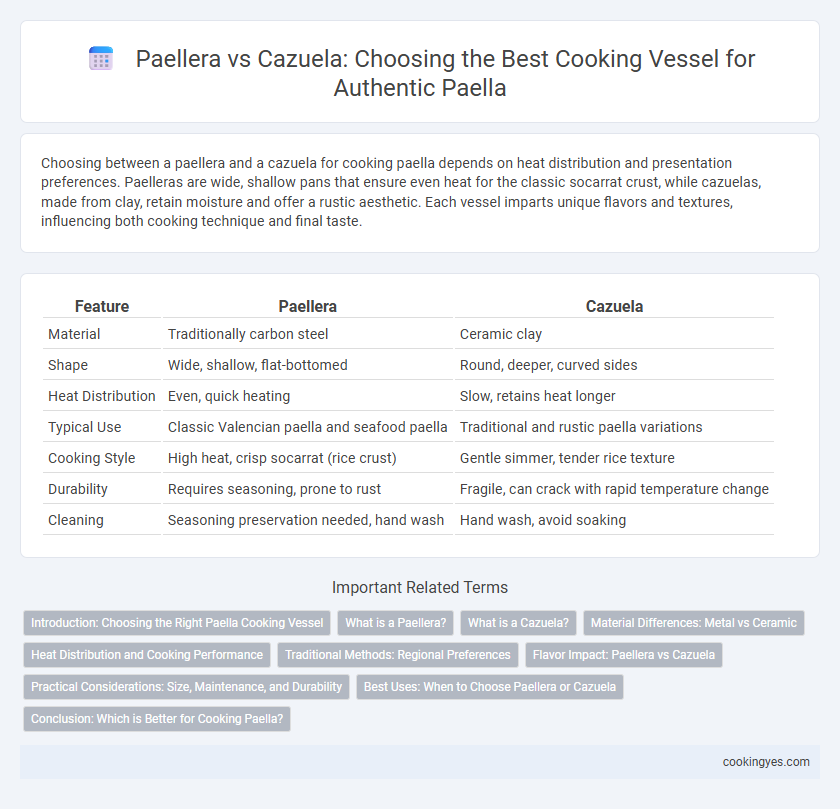Choosing between a paellera and a cazuela for cooking paella depends on heat distribution and presentation preferences. Paelleras are wide, shallow pans that ensure even heat for the classic socarrat crust, while cazuelas, made from clay, retain moisture and offer a rustic aesthetic. Each vessel imparts unique flavors and textures, influencing both cooking technique and final taste.
Table of Comparison
| Feature | Paellera | Cazuela |
|---|---|---|
| Material | Traditionally carbon steel | Ceramic clay |
| Shape | Wide, shallow, flat-bottomed | Round, deeper, curved sides |
| Heat Distribution | Even, quick heating | Slow, retains heat longer |
| Typical Use | Classic Valencian paella and seafood paella | Traditional and rustic paella variations |
| Cooking Style | High heat, crisp socarrat (rice crust) | Gentle simmer, tender rice texture |
| Durability | Requires seasoning, prone to rust | Fragile, can crack with rapid temperature change |
| Cleaning | Seasoning preservation needed, hand wash | Hand wash, avoid soaking |
Introduction: Choosing the Right Paella Cooking Vessel
A paellera, a wide, shallow, flat-bottomed pan with two handles, distributes heat evenly to create the iconic socarrat crust essential for traditional paella. In contrast, a cazuela, typically deeper and made of clay, retains moisture and provides a rustic flavor but may cook unevenly. Selecting the right vessel depends on the desired texture and cooking method, with paellera favored for authentic, crisp-bottomed paellas.
What is a Paellera?
A Paellera is a wide, shallow, flat-bottomed pan made of carbon steel, essential for creating authentic Spanish paella with its large surface area that ensures even cooking and socarrat formation. Unlike a cazuela, which is a smaller, round, and often earthenware pot used for slower, more evenly distributed heat in stews, the paellera allows high heat exposure and quick evaporation of liquid, crucial for traditional paella texture. Its design promotes optimal heat distribution and easy technique control, making it the preferred vessel for classic Valencian paella.
What is a Cazuela?
A cazuela is a traditional Spanish clay pot used for cooking a variety of dishes, including paella, known for its excellent heat retention and even cooking. Unlike the flat and wide paellera, the cazuela has deeper sides, which makes it ideal for stews but can affect the cooking process of paella by trapping more moisture. Clay cazuelas impart a distinct earthy flavor and are perfect for smaller, rustic paellas or other Mediterranean recipes requiring slow, consistent heat.
Material Differences: Metal vs Ceramic
Paelleras are traditionally made from metal, usually carbon steel or stainless steel, offering excellent heat conduction and durability for even cooking and quick temperature adjustments. Cazuelas, crafted from ceramic, retain heat longer and provide a more gentle, diffused cooking environment, which enhances flavor development but may result in slower cooking. The choice between metal and ceramic impacts the texture and consistency of the paella, with metal promoting the signature socarrat crust and ceramic yielding a tender, stew-like finish.
Heat Distribution and Cooking Performance
The paellera, a wide and shallow round pan, ensures even heat distribution due to its thin metal construction, making it ideal for traditional paella cooking over an open flame. In contrast, the cazuela, typically made of clay, offers excellent heat retention but tends to heat unevenly, which can affect the consistent cooking of the rice and ingredients. While the paellera promotes a crispy socarrat layer with uniform cooking, the cazuela provides a rustic flavor profile but requires careful heat management to avoid hotspots.
Traditional Methods: Regional Preferences
The Paellera, a wide, shallow, and flat pan, is traditionally favored in Valencia for its ability to evenly cook the socarrat, the prized crispy rice layer. In contrast, the Cazuela, a deep, round earthenware pot, is preferred in regions like Catalonia and Murcia, where paella recipes incorporate more broth and require slower, gentler cooking. These regional preferences highlight the influence of local ingredients and cooking techniques on the choice of paella vessel.
Flavor Impact: Paellera vs Cazuela
The paellera, with its wide, shallow design, promotes even heat distribution and caramelization, enhancing the characteristic socarrat layer that intensifies the flavor of traditional paella. In contrast, the cazuela, a deeper, earthenware pot, retains moisture better but may produce a less crispy texture, resulting in a richer, stew-like flavor profile. Flavor impact varies as the paellera emphasizes a toasted, smoky essence, while the cazuela yields a more robust, slow-cooked depth.
Practical Considerations: Size, Maintenance, and Durability
A paellera typically offers a wide, shallow surface ideal for even heat distribution and achieving the signature crispy socarrat, with sizes ranging from 12 to 22 inches to accommodate various servings. Made of carbon steel, paelleras require regular seasoning to prevent rust but boast excellent durability and develop a natural non-stick surface over time. In contrast, cazuelas, crafted from clay or ceramic, retain heat well and add flavor complexity but are more fragile, heavier, and demand careful maintenance to avoid cracking or chipping.
Best Uses: When to Choose Paellera or Cazuela
Paellera is ideal for cooking traditional Valencian paella over an open flame or grill, providing even heat distribution and allowing the socarrat to develop perfectly. Cazuela, a ceramic vessel, excels in slow-cooked, stew-like paellas where gentle, consistent heat retains moisture and deepens flavors. Choose Paellera for crisp, dry paellas with a smoky crust; opt for Cazuela when preparing moist, hearty paellas with tender ingredients.
Conclusion: Which is Better for Cooking Paella?
Paellera offers a wide, flat surface perfect for even rice cooking and crispy socarrat formation, making it ideal for traditional paella preparation. Cazuela, being rounder and deeper, is better suited for stews but can hinder the even cooking and caramelization needed for authentic paella. For authentic flavor and texture, the paellera remains the superior choice as a paella cooking vessel.
Paellera vs Cazuela for Paella cooking vessel Infographic

 cookingyes.com
cookingyes.com